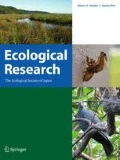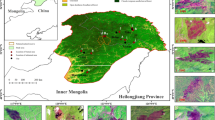Abstract
We studied the altitudinal patterns of plant species richness and examined the effects of geometric constraints, area, and climatic factors on the observed richness patterns along the ridge of the Baekdudaegan Mountains, South Korea. Rapoport’s altitudinal rule was evaluated by examining the relationship between altitudinal range size and midpoint. We also examined the latitudinal effect on species richness. Plant data were collected from 1,100 plots along a 200–1,900 m altitudinal gradient along the ridge of the Baekdudaegan. A total of 802 plant species from 97 families and 342 genera were found. The altitudinal patterns of plant species richness along the ridge of the Baekdudaegan depicted distinctly hump-shaped patterns, although the absolute altitudes of the richness peaks vary somewhat among plant groups. While the mid-domain effect (MDE) was the most powerful explanatory variable in simple regression models, species richness was also associated with climatic factors, especially mean annual precipitation (MAP) and temperature (MAT) in multiple regression models. The relative importance of the MDE and climatic factors were different among plant groups. The MDE was more important for woody plants and for large-ranged species, whereas climatic factors were better predictors for total and herbaceous plants and for small-ranged species. Rapoport’s altitudinal rule and a latitudinal effect on species richness were not supported. Our study suggests that a combined interaction of the MDE and climatic factors influences species richness patterns along the altitudinal gradient of the Baekdudaegan Mountains, South Korea.





Similar content being viewed by others
References
Acharya BK, Chettri B, Bijayan L (2011) Distribution patterns of trees along an elevation gradient Eastern Himalaya, India. Acta Oecol 37:329–336
Ah-Peng C, Wilding N, Kluge J, Descamps-Julien B, Bardat J, Chuah-Petiot M, Strasberg D, Hedderson TAJ (2012) Bryophyte diversity and range size distribution along two altitudinal gradients: continent versus island. Acta Oecol 42:58–65
Alexander JM, Kueffer C, Daehler CC, Edwards PJ, Pauchard A, Seipel T, Consortium M (2011) Assembly of nonnative floras along elevational gradients explained by directional ecological filtering. Proc Natl Acad Sci USA 108:656–661
Aubry S, Magnin F, Bonnet V, Preece RC (2005) Multi-scale altitudinal patterns in species richness of land snail communities in south-eastern France. J Biogeogr 32:985–998
Bachman S, Baker WJ, Brummitt N, Dransfield J, Moat J (2004) Elevational gradients, area, and tropical island diversity: an example from the palms of New Guinea. Ecography 27:299–310
Beck J, Chey VK (2008) Explaining the elevational diversity pattern of geometrid moths from Borneo: a test of five hypotheses. J Biogeogr 35:1452–1464
Bhattarai KR, Vetaas OR (2003) Variation in plant species richness of different life forms along a subtropical elevational gradient in the Himalayas, east Nepal. Global Ecol Biogeogr 12:327–340
Bhattarai KR, Vetaas OR (2006) Can Rapoport’s rule explain tree species richness along the Himalayan elevational gradient, Nepal? Divers Distrib 12:373–378
Bhattarai KR, Vetaas OR, Grytnes JA (2004) Fern species richness along a Central Himalayan elevational gradient. Nepal. J Biogeogr 31:389–400
Braun-Blanquet J (1965) Plant sociology. Hafner, New York
Brown JH, Lomolino MV (1998) Biogeography, 2nd edn. Sinauer, Sunderland
Buckley HL, Miller TE, Ellison AM, Gotelli NJ (2003) Reverse latitudinal trends in species richness of pitcher-plant food webs. Ecol Lett 6:825–829
Cardelús CL, Colwell RK, Watkins JE (2006) Vascular epiphyte distribution patterns: explaining the mid-elevation richness peak. J Ecol 94:144–156
Carpenter C (2005) The environmental control of plant species density on a Himalayan elevation gradient. J Biogeogr 32:999–1018
Colwell RK (2006) RangeModel: a Monte Carlo simulation tool for assessing geometric constraints on species richness. Version 5. User’s Guide and application published at: http://viceroy.eeb.uconn.edu/rangemodel
Colwell RK (2009) Estimate S: Statistical estimation of species richness and shared species from samples. Version 8.2. User’s Guide and application published at: http://purl.oclc.org/estimates
Colwell RK, Hurtt GC (1994) Nonbiological gradients in species richness and a spurious Rapport effect. Am Nat 144:570–595
Colwell RK, Lees DC (2000) The mid-domain effect: geometric constraints on the geography of species richness. Trends Ecol Evol 15:70–76
Colwell RK, Mao CX, Chang J (2004a) Interpolating, extrapolating and comparing incidence-based species accumulation curves. Ecology 85:2717–2727
Colwell RK, Rahbek C, Gotelli NJ (2004b) The mid-domain effect and species richness patterns: what have we learned so far? Am Nat 163:E1–E23
Connor EF, McCoy ED (1979) The statistics and biology of the species-area relationship. Am Nat 113:791–833
Cruz FB, Fitzgerald LA, Espinoza RE, Schulte JA (2005) The importance of phylogenetic scale in tests of Bergmann’s and Rapoport’s rules: lessons from a clade of South American lizards. J Evol Biol 18:1559–1574
Diniz-Filho JAE, Bini LM, Hawkins BA (2003) Spatial autocorrelation and red herrings in geographical ecology. Global Ecol Biogeogr 12:53–64
Dunn RR, Colwell RK, Nilsson C (2006) The river domain: why are there more species halfway up the river? Ecography 29:251–259
Fang JY, Lechowicz MJ (2006) Climatic limits for the present distribution of beech (Fagus L.) species in the world. J Biogeogr 33:1804–1819
Fu C, Wu J, Wang X, Lei G, Chen J (2004) Patterns of diversity, altitudinal range and body size among freshwater fishes in the Yangtze River basin, China. Global Ecol Biogeogr 13:543–552
Fu C, Hua X, Li J, Chang Z, Pu Z, Chen J (2006) Elevational patterns of frog species richness and endemic richness in the Hengduan Mountains, China: geometric constraints, area and climate effects. Ecography 29:919–927
Grau O, Grytnes JA, Birks HJB (2007) A comparison of altitudinal species richness patterns of bryophytes with other plant groups in Nepal, Central Himalaya. J Biogeogr 34:1907–1915
Grytnes JA, Vetaas OR (2002) Species richness and altitude: a comparison between null models and interpolated plant species richness along the Himalayan altitudinal gradient. Nepal. Am Nat 159:294–304
Grytnes JA, Heegaard E, Ihlen PG (2006) Species richness of vascular plants, bryophytes, and lichens along an altitudinal gradient in western Norway. Acta Oecol 29:241–246
Jetz W, Rahbek C (2002) Geographic range size and determinants of avian species richness. Science 297:1548–1551
Karger DN, Kluge J, Krömer T, Hemp A, Lehnert M, Kessler M (2011) The effect of area on local and regional elevational patterns of species richness. J Biogeogr 38:1177–1185
Kattan GH, Franco P (2004) Bird diversity along elevational gradients in the Andes of Colombia: area and mass effects. Global Ecol Biogeogr 13:451–458
Kluge J, Kessler M, Dunn RR (2006) What drives elevational patterns of diversity? A test of geometric constraints, climate and species pool effects for pteridophytes on an elevational gradient in Costa Rica. Global Ecol Biogeogr 15:358–371
Kong WS (2008) Biogeography of Korea Plants, 2nd edn (in Korean). GeoBook, Seoul
Korea Forest Research Institute (2003) Ecological aspects of Baekdu Mountains in Korea and delineation of their management and conservation area (in Korean). Korea Forest Research Institute [report no. 198], Seoul
Lee PF, Ding TS, Hsu FH, Geng S (2004) Breeding bird species richness in Taiwan: distribution on gradients of elevation, primary productivity and urbanization. J Biogeogr 31:307–314
Li JS, Song YL, Zeng ZG (2003) Elevational gradients of small mammal diversity on the northern slopes of Mt. Qilian, China. Global Ecol Biogeogr 12:449–460
Li J, He Q, Hua X, Zhou J, Xu H, Chen J, Fu C (2009) Climate and history explain the species richness peak at mid-elevation for Schizothorax fishes (Cypriniformes: Cyprinidae) distributed in the Tibetan Plateau and its adjacent regions. Global Ecol Biogeogr 18:264–272
Liew TS, Schilthuizen M, Lakim M (2010) The determinants of land snail diversity along a tropical elevational gradient: insularity, geometry and niches. J Biogeogr 37:1071–1078
Marini L, Bona E, Kunin WE, Gaston KJ (2010) Exploring anthropogenic and natural processes shaping fern species richness along elevational gradient. J Biogeogr 38:78–88
McCain CM (2004) The mid-domain effect applied to elevational gradients: species richness of small mammals in Costa Rica. J Biogeogr 31:19–31
McCain CM (2005) Elevational gradients in diversity of small mammals. Ecology 86:366–372
McCain CM (2007) Area and mammalian elevational diversity. Ecology 88:76–86
McCain CM (2009) Global analysis of bird elevational diversity. Global Ecol Biogeogr 18:346–360
Oommen MA, Shanker K (2005) Elevational species richness patterns emerge from multiple local mechanisms in Himalayan woody plants. Ecology 86:3039–3047
Rahbek C (1995) The elevational gradient of species richness: a uniform pattern? Ecography 18:200–205
Rahbek C (2005) The role of spatial scale and the perception of large-scale species-richness patterns. Ecol Lett 8:224–239
Rangel TF, Diniz-Filho JAF, Bini LM (2010) SAM: a comprehensive application for spatial analysis in macroecology. Ecography 33:46–50
Rohde K, Heap M, Heap D (1993) Rapoport’s rule does not apply to marine teleosts and cannot explain latitudinal gradients in species richness. Am Nat 142:1–16
Romdal TS, Grytnes JA (2007) An indirect area effect on elevational species richness patterns. Ecography 30:440–448
Rosenzweig ML (1995) Species diversity in space and time. Cambridge University Press, Cambridge
Rowe RJ (2009) Environmental and geometric drivers of small mammal diversity along elevational gradients in Utah. Ecography 32:411–422
Sanders NJ (2002) Elevational gradients in ant species richness: area, geometry, and Rapoport’s rule. Ecography 25:25–32
Sanders NJ, Moss J, Wagner D (2003) Patterns of ant species richness along elevational gradients in an arid ecosystem. Global Ecol Biogeogr 12:93–102
Shin JH (2002) Ecosystem geography of Korea. In: Lee DW, Jin V, Choe JC, Son YW, Yoo SJ, Lee HY, Hong SK, Ihm BS (eds) Ecology of Korea. Bumwoo, Seoul, pp 19–46
Stevens GC (1989) The latitudinal gradient in geographical range: how so many species coexist in the tropics. Am Nat 133:240–256
Stevens GC (1992) The elevational gradient in altitudinal range: an extension of Rapoport’s latitudinal rule to altitude. Am Nat 140:893–911
Wang Z, Tang Z, Fang J (2007) Altitudinal patterns of seed plant richness in the Gaoligong Mountains, south-east Tibet, China. Divers Distrib 13:845–854
Watkins JE, Cardelús C, Colwell RK, Moran RC (2006) Species richness and distribution of ferns along an elevational gradient in Costa Rica. Am J Bot 93:73–83
Webb TJ, Gaston KJ (2003) On the heritability of geographic range sizes. Am Nat 161:553–566
Yim YJ (1977) Distribution of forest vegetation and climate in the Korean Peninsula: IV. zonal distribution of forest vegetation in relation to thermal climate. Jpn J Ecol 27:269–278
Yim YJ, Kira T (1975) Distribution of forest vegetation and climate in the Korean Peninsula: I. distribution of some indices of thermal climate. Jpn J Ecol 25:77–88
Zapata FA, Gaston KJ, Chown SL (2003) Mid-domain models of species richness gradients: assumptions, methods and evidence. J Anim Ecol 72:677–690
ZenHua S, ShengJin P, XiaoKun O (2007) Rapid assessment and explanation of tree species abundance along the elevation gradient in Gaoligong Mountains, Yunnan, China. Chin Sci Bull 52:225–231
Acknowledgments
We thank Mr. Keun-Wook Lee and Mr. Sang-Hyouk Seo for invaluable help during the fieldwork and data analysis in this study. Thanks are also due to Dr. Joon-Hwan Shin and Dr. Sang-Gon Park for their support and encouragement. This paper forms a part of the “Korea Big Tree Project” funded by the Korea Green Promotion Agency, Korea Forest Service.
Author information
Authors and Affiliations
Corresponding author
Electronic supplementary material
Below is the link to the electronic supplementary material.
About this article
Cite this article
Lee, CB., Chun, JH., Song, HK. et al. Altitudinal patterns of plant species richness on the Baekdudaegan Mountains, South Korea: mid-domain effect, area, climate, and Rapoport’s rule. Ecol Res 28, 67–79 (2013). https://doi.org/10.1007/s11284-012-1001-1
Received:
Accepted:
Published:
Issue Date:
DOI: https://doi.org/10.1007/s11284-012-1001-1




